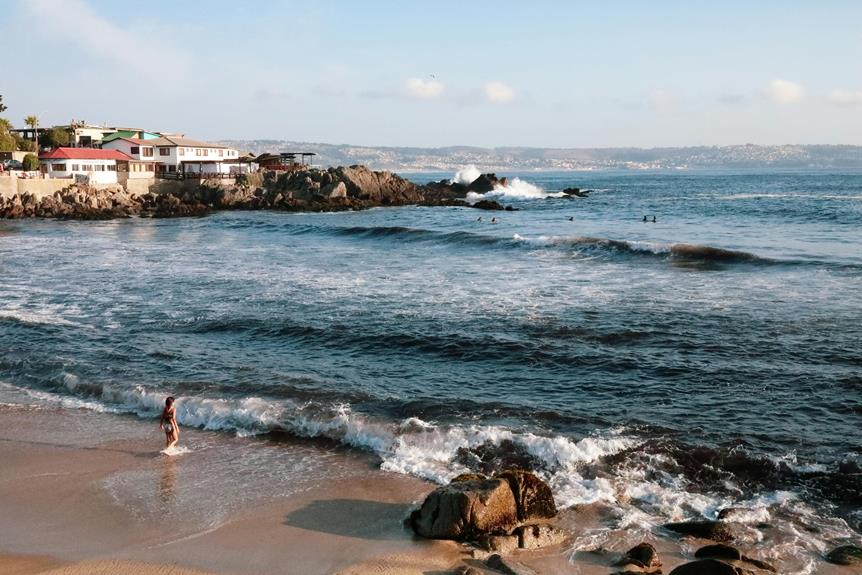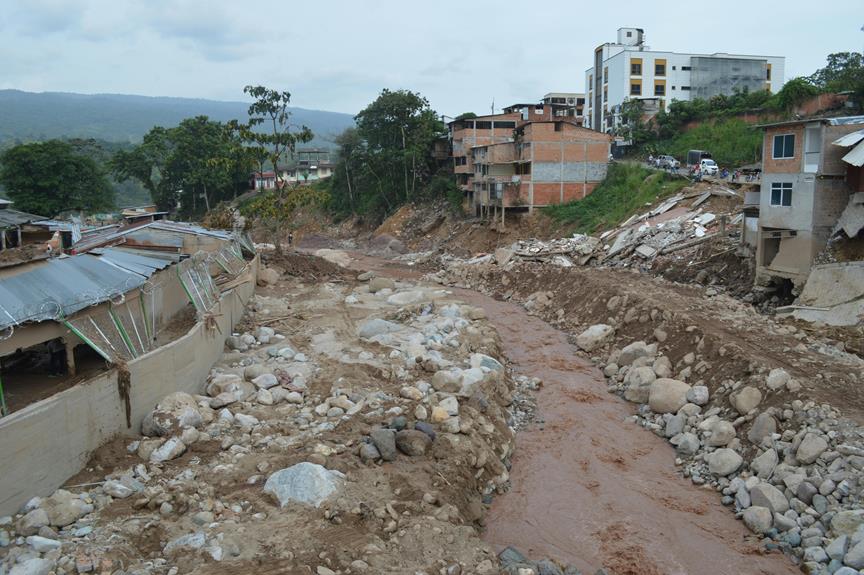The enigmatic history of Easter Island, Chile, continues to intrigue scholars and enthusiasts alike. The collapse of the Rapa Nui society stands as a poignant reminder of the delicate balance between human civilization and the environment. As we explore the events leading to this societal downfall, questions arise about the decisions made by the islanders and the repercussions of their actions. What lessons can be gleaned from this ancient tale of environmental mismanagement and societal collapse, and how can we apply them to our present-day challenges?
Key Takeaways
- Deforestation led to soil erosion and agricultural decline.
- Resource depletion caused extinction and societal destabilization.
- Unsustainable resource exploitation exacerbated societal collapse.
- Internal power struggles contributed to societal downfall.
- Lessons on resilience and adaptation for contemporary societies.
The Mystique of Easter Island
The crucial charm of Easter Island lies in its remote location, mesmerizing statues, and mysterious history that have fascinated researchers and visitors alike for centuries. Central to this allure are the mysterious sculptures, known as moai, scattered across the island. These monolithic figures, some towering up to 33 feet high and weighing as much as 80 tons, are shrouded in mystery regarding their purpose and the techniques used to create and transport them.
The cultural preservation of these sculptures is a paramount concern for both the local Rapa Nui people and the global community. Efforts to safeguard these iconic symbols of Easter Island's past have been ongoing, with initiatives aimed at preventing further deterioration due to environmental factors and human activity. The delicate balance between promoting tourism, which is crucial for the local economy, and ensuring the protection of these sacred artifacts is a continuous challenge.
Moreover, the intricate link between the sculptures and the island's enigmatic history adds layers of complexity to the preservation efforts. Unraveling the mysteries surrounding the creation and meaning of these statues is not only a scholarly pursuit but also a means of deepening our understanding of the Rapa Nui civilization and its eventual decline. By safeguarding these cultural treasures, Easter Island can continue to captivate and inspire generations to come with its enigmatic past.
Arrival of the Polynesians
Upon reaching the shores of Easter Island, the Polynesians commenced a journey of exploration and settlement that would shape the island's cultural and environmental landscape. The Polynesian settlement on Easter Island was a pivotal moment in history, marking the beginning of a new chapter for the isolated island in the vast Pacific Ocean. Here are four key aspects that highlight the significance of the Polynesians' arrival:
- Cultural Fusion: The Polynesians brought with them their unique customs, language, and traditions, which intermingled with the existing practices of the island's early settlers. This cultural fusion laid the foundation for the distinctive Rapa Nui culture that would evolve over centuries.
- Environmental Adaptation: The Polynesians had to adapt to the island's challenging environmental conditions, including its remote location and limited resources. Through their ingenuity and resourcefulness, they developed sustainable farming practices and utilized the island's natural resources wisely.
- Technological Advancements: The arrival of the Polynesians introduced new technologies to Easter Island, such as advanced fishing techniques, refined agricultural methods, and innovative tools for construction. These advancements enabled the islanders to thrive in their new home.
- Legacy of Exploration: The Polynesians' arrival marked the beginning of an era of exploration and discovery for Easter Island. Their navigational skills and seafaring prowess laid the groundwork for future voyages across the Pacific, leaving a lasting legacy of exploration and cultural exchange.
Rise of the Moai Statues
Amidst the rugged terrain of Easter Island, colossal stone figures known as Moai emerged as iconic symbols of the island's cultural and societal evolution. These statues, carved from volcanic tuff, are characterized by elongated faces and prominent noses, each unique in its features. The Moai statues are believed to represent ancestors, chiefs, or other important figures in Rapa Nui society, signifying the spiritual and political significance they held.
The cultural significance of the Moai statues is profound, reflecting the beliefs and practices of the Rapa Nui people. These statues were not merely artistic expressions but served as markers of identity, power, and lineage within the community. Through archaeological discoveries, researchers have uncovered insights into the craftsmanship and ritualistic practices involved in the creation and placement of the Moai statues.
Archaeological excavations have revealed the intricate details of how these massive statues were carved, transported, and erected across the island. The sheer size and number of Moai scattered throughout Easter Island attest to the advanced engineering skills and organizational capacity of the ancient Rapa Nui civilization. The presence of the Moai statues continues to fascinate and intrigue visitors, offering a glimpse into the rich history and cultural heritage of Easter Island.
Environmental Degradation Theories
Emerging from the historical context of Easter Island's cultural and societal evolution through the construction of the Moai statues, various environmental degradation theories have been proposed to shed light on the island's ecological challenges.
- Deforestation consequences: The once lush palm forests of Easter Island dwindled as the islanders used trees for various purposes, including transporting the massive Moai statues. This deforestation led to a loss of biodiversity, soil erosion, and a decline in water quality.
- Soil erosion effects: With the extensive clearing of trees, the island's soil became exposed to the elements, causing erosion and degradation. The essential topsoil that was vital for agriculture was washed away, leading to decreased agricultural productivity and exacerbating food scarcity on the island.
- Resource depletion implications: The depletion of natural resources, particularly wood for construction and transportation, played a significant role in the collapse of the island's civilization. This resource scarcity not only impacted the island's ability to sustain its population but also contributed to social unrest and conflict over dwindling resources.
- Climate change considerations: Some theories suggest that environmental changes caused by deforestation and soil erosion may have altered the island's microclimate, further exacerbating environmental stress and making it even more challenging for the islanders to adapt and thrive in their changing ecosystem.
Impact of Resource Depletion
The repercussions of resource depletion on Easter Island's ecosystem and society were profound and far-reaching, shaping the course of its eventual collapse. The ecological consequences of the island's deforestation, primarily driven by the excessive demands for resources to construct monumental statues known as Moai, led to a cascade of detrimental effects. The loss of trees resulted in soil erosion, decreased agricultural productivity, and the extinction of various plant and animal species. This environmental degradation not only disrupted the delicate balance of the island's ecosystem but also compromised its ability to sustain the growing population.
Furthermore, the cultural implications of resource depletion were significant. The depletion of natural resources strained social cohesion as competition for dwindling supplies intensified. The societal hierarchy, which was closely tied to the construction and transportation of Moai, was destabilized as resources became scarce. This depletion also impacted the islanders' spiritual beliefs and practices, as the environmental devastation altered the landscape that held profound cultural significance.
Unraveling the Rapa Nui Collapse
The intricate web of factors contributing to the Rapa Nui collapse on Easter Island demands a meticulous unraveling to comprehend the full scope of its societal and environmental implications.
- Archaeological Evidence:
Delving into the archaeological record provides essential insights into the gradual decline of the Rapa Nui civilization. Excavations revealing abandoned settlements, depleted resources, and the iconic moai statues in various stages of construction offer a window into the past society's challenges.
- Environmental Degradation:
Uncovering the extent of deforestation, soil erosion, and loss of biodiversity through scientific analysis allows us to grasp how environmental degradation played a pivotal role in exacerbating societal collapse. The exploitation of natural resources beyond sustainable limits had a significant impact on the island's ecosystem.
- Societal Dynamics:
Examining the intricate social structures, power struggles, and resource management practices of the Rapa Nui people sheds light on the internal factors that contributed to their downfall. Understanding the societal dynamics and cultural norms helps us piece together the narrative of a civilization in crisis.
- Resilience and Adaptation:
Despite facing immense challenges, exploring instances of resilience and adaptation within the Rapa Nui society reveals the complexities of their responses to adversity. Analyzing how different segments of the population coped with environmental and social changes provides valuable lessons for contemporary societies grappling with similar issues.
Frequently Asked Questions
What Was the Significance of the Red Hats on the Moai Statues?
The red hats on the moai statues held symbolic significance within the cultural practices of the society that created them. These hats were not mere adornments but rather representations of specific roles, statuses, or rituals.
Understanding the cultural context and beliefs surrounding these red hats can provide valuable insights into the societal structure, religious practices, or ceremonial traditions of the community that sculpted these iconic statues.
How Did the Ancient Rapa Nui People Transport the Massive Statues?
Transporting massive statues was a display of ingenuity for ancient civilizations. Stone transportation was a reflection of their engineering marvels. Utilizing logs, ropes, and manpower, these cultures moved colossal structures with precision and coordination.
The process exemplified their ability to problem-solve and innovate in resource-constrained environments. This ancient practice continues to inspire awe and admiration for the craftsmanship and determination of these early societies.
Were There Any Other Factors Contributing to Environmental Degradation?
Deforestation impact and soil erosion were prevalent factors contributing to environmental degradation. Cultural practices, coupled with inadequate resource management, exacerbated these issues.
The loss of vegetation led to soil erosion, affecting agricultural productivity and ecosystem stability. Over time, this degradation likely played a significant role in the decline of the local environment, impacting the sustainability of the community's resources and overall well-being.
What Role Did Social Hierarchy Play in the Rapa Nui Collapse?
Within the annals of history, social hierarchy has often been a defining factor in the unraveling of civilizations.
In the case of the Rapa Nui Collapse, the role of social structure was pivotal.
The hierarchical system intertwined with resource management, potentially leading to disparities in access and distribution, exacerbating environmental degradation.
This intricate interplay underscores the importance of examining societal constructs when analyzing the downfall of complex societies.
Is There Evidence of Contact With Other Civilizations During That Time?
Cultural exchange and trade networks are essential components of understanding contact with other civilizations in a historical context. Evidence of interactions with external groups can be gleaned from archaeological findings, such as imported goods, artifacts, or architectural influences.
These connections provide insights into the dynamics of cross-cultural encounters and the extent to which societies engaged in exchange and cooperation with distant populations, shaping their material culture and societal structures.
Conclusion
In the enigmatic landscape of Easter Island, the rise and fall of the Rapa Nui civilization serves as a poignant reminder of the consequences of environmental degradation and unsustainable resource management.
The haunting statues of the moai stand as silent witnesses to a society that grappled with the intricate interplay between human actions and the natural world.
Through the lens of Easter Island's history, we are compelled to reflect on the fragility of societies and the enduring lessons of resilience and adaptation.


